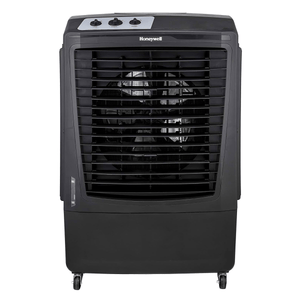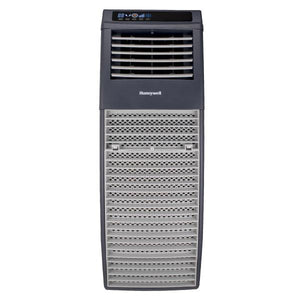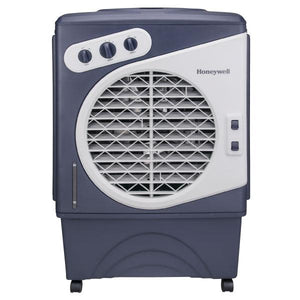
How to Use an Evaporative Cooler as a Humidifier
As winter comes into full swing, you might be noticing some unwanted side effects of the season: dry eyes, cracked hands, or irritated respiratory passageways. You might also be wondering how you can continue to protect yourself and your family from serious illnesses like COVID-19 or the flu. One way to stay healthy and comfortable is to increase your home’s humidity levels. While a traditional humidifier can help you with these issues, an evaporative air cooler can provide you with winter relief—and more!
What is humidity, and why does it matter?

Regulating your indoor humidity is just as important as regulating your indoor temperature. Humidity is the amount of water vapor in the air, while relative humidity (RH) measures the percentage of moisture in the air compared to the amount of moisture the air can hold at a given temperature. To monitor humidity measurements in your home, you can purchase a moisture meter for around $10 at your local hardware store.
Cold air isn’t as effective at retaining moisture as warm air is, so the air inside our homes becomes drier and more difficult to manage in the winter. Your heating system only draws more moisture out of the air. You can tell the humidity has started to change in the winter when you start experiencing uncomfortable sensations like dry eyes, cracked skin, or chapped lips. When it’s dry enough indoors to cause irritation, that means it’s dry enough to negatively impact your health and home. That’s where humidifiers come in.
Why is an evaporative air cooler better than just a humidifier?
Humidifying appliances are excellent solutions to combat winter dryness and its accompanying issues. Not only do they reduce the number of bacteria in the air simply by increasing humidity, but they also feature filters that help keep dust, dirt, and other airborne particles out of the air you breathe. (Just remember to clean or replace the filters according to the manufacturer’s instructions.) While you can purchase a standalone humidifier, it might be beneficial to invest in an evaporative air cooler instead. Humidifiers are only able to address a room’s RH level, but they have no effect on room temperature. With an air cooler, you can run it as a humidifier year-round with the added benefit of having a cooling appliance for the hotter months.

Evaporative air coolers draw in air which then passes through a wet honeycomb cooling media. As the air passes through the media, it mixes with the water held in the honeycomb, causing the water to evaporate and lose heat, resulting in cooler, moistened air that a fan then propels into the room. This operation is very similar to that of an evaporative humidifier, which uses a fan to run air through a damp filter soaked in a reservoir of water.
Using an evaporative cooler as a humidifier doesn’t require an open window, but as it warms up, you’ll want to open your windows for ventilation. Not only does this ensure your air cooler draws in new air to create a nice, refreshing breeze, but it’s a safer way to cool down during the pandemic. The World Health Organization (WHO) notes that “the risk of getting COVID-19 infection is increased in crowded and poorly ventilated settings” since “the virus passes between people through infected respiratory particles.”
As the WHO states, “The majority of wall or window unit air conditioning systems do not provide ventilation.” Unlike traditional air conditioners, evaporative air coolers draw in air from the outside instead of recycling stale air. So not only does an evaporative cooler let you keep cool in warm months while following CDC recommendations to “open doors and windows as much as you can to bring in fresh, outdoor air,” but it serves double duty as a humidifier for when it’s cold as well as throughout the year.
Humidity and your health

The Mayo Clinic has stated that ideal household humidity levels are between 30-50%. When air gets colder in the winter, it also gets drier, sometimes dropping indoor RH levels below 30%. When humidity levels get that low, you and your household are at increased risk for the transmission of viruses, like COVID-19 or the flu, and other health hazards. Dr. Akiko Iwasaki, immunology professor and COVID-19 researcher at Yale, has stated that dry air is known to help spread seasonal viruses like the flu as it’s a “key factor that impairs a person’s ability to fight off respiratory viral infections”.
In 2007, researchers at Mount Sinai School of Medicine reported that influenza virus transmission depends on relative humidity and temperature, finding that the flu is significantly less likely to be transmitted in an environment of 68°F or warmer with a relative humidity of 50% or above. Viruses and bacteria just don’t travel as well in moist air. One 2013 study found that higher indoor humidity actually inactivates flu virus particles. Researchers found that when released into a room with a RH level of 23% or less, between 70-77% of viral particles remained infectious; however, when humidity was increased to about 43%, only 14% of the virus particles were able to infect cells.
In addition to helping keep you safe from viruses and bacteria, humidifiers can prevent or soothe other health-related issues that dry air can cause, like scratchy throats and bloody noses. When those problems arise, trying to get some relief by swallowing can cause even more irritation and inflammation. Research has even shown that breathing in dry air can lead to health issues like asthma and bronchitis. When do you have a cold, dry air can make it more difficult to recover. But when humidity levels in the air increase, nasal passages can open and allow mucus to flow more easily, letting you breathe more freely.
Evaporative air coolers and humidifiers can also help relieve common wintertime irritations like eye dryness, cracked skin, and chapped lips. When they restore moisture in the air, they also restore moisture in your skin. Raising humidity levels can also improve your sleep. If your nose and throat are irritated when you go to bed, you might end up tossing and turning or waking up your partner with your snoring, and you could be left feeling parched when you wake up. Simply increasing your room’s humidity levels can help mitigate these issues.
Humidity and your home

Not only are low RH levels bad for you, but they’re also bad for your home. Dry air can damage all of the wood in your home, including hardwood floors, crown molding, any wooden furniture, and instruments like guitars. It can cause bubbling, gaps, or cracks to appear in wood when too much moisture has been sucked out, leaving you with costly damage to repair. One of the simplest ways to extend the life of your property is to invest in an air cooler or humidifier to address indoor humidity and ensure it remains at a constant level.
Dry air in the winter months can also increase static electricity. While static electricity might seem like a silly concern when it frizzes up your hair or zaps you when you wear socks, it can actually damage electronics or even create a fire hazard. Properly humidified air, however, can limit or even prevent most problems stemming from static electricity.
The effects of dry air, which can affect your comfort, health, and home, can be countered by using a humidifier, especially in winter. When you use an evaporative air cooler as a humidifier, not only do you save money by purchasing only one appliance, but you ensure that you’ll have a nice, well-ventilated home in the summer in addition to a year-round humidifying unit.






